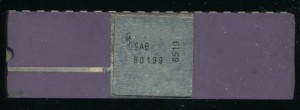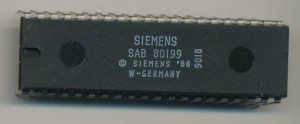Siemens SAB80199: 16-bits for Europe
By 1982 Siemens has firmly established themselves as a semiconductor powerhouse in West Germany, and the entirely of western Europe. Their manufacturing prowess led them to be Intel’s second source of choice in Europe, building 8008,8080, and 8086/8 processors, with production beginning for the 186 and 286s processors as well. Siemens’ expertise was not just in making second sourcing others work, they had their own design/development as well, doing a large amount of work for the industrial automation market as well as others.
In late 1982 they announced a new 16-bit processor, one of their own design. Production began in 1983 and continued for over a decade. The 80199 had a 8086 compatible bus, but that’s where the similarities end. The 80199 is often described as a ‘Terminal COntrol Processor’ or a ‘Printer Controller’ which is a bit deceptive. It was designed from the outset as a real time processor, capable of handling multiple real time tasks.
The SAB80199 was built on a 3 micron NMOS process and contains 40,000 transistors on a 45mm2 die. Clock speed is 20 MHz (faster then most anything else in 1983) and had an instruction cycle of 0.5 microseconds. It moved many of the RTOS functions from software (or an external chip like Intel’s 80130 RTOS co-processor for the 808x) to on chip hardware. It had 8 status registers, 8 instruction pointers, and 8 sets of registers. This allowed very rapid task switching as each tasks data did not have to be saved/restored, a complete task switch took 1 microsecond to complete. In addition the 80199 had another feature that was rather novel at the time, cache. The processor contained an on chip instruction cache the could hold 16, 16-bit instructions. For some sets of code, such as a simple loop, the entirely of the instructions for it, would reside on chip, resulting in very fast execution. Today of course caches for data/instructions are normal, and very large, measured in KB and MB but in 1983 it was virtually unknown.
In 1983 the ‘West Europe Report’ called Siemens 80199 the ‘Fast Bavarian’, fast indeed, and it was adopted across Europe, but never made it to the American market in any quantity. It is perhaps one of the ‘forgottens’ but certainly deserves a place in the history of real time computing.
Posted in:
CPU of the Day



